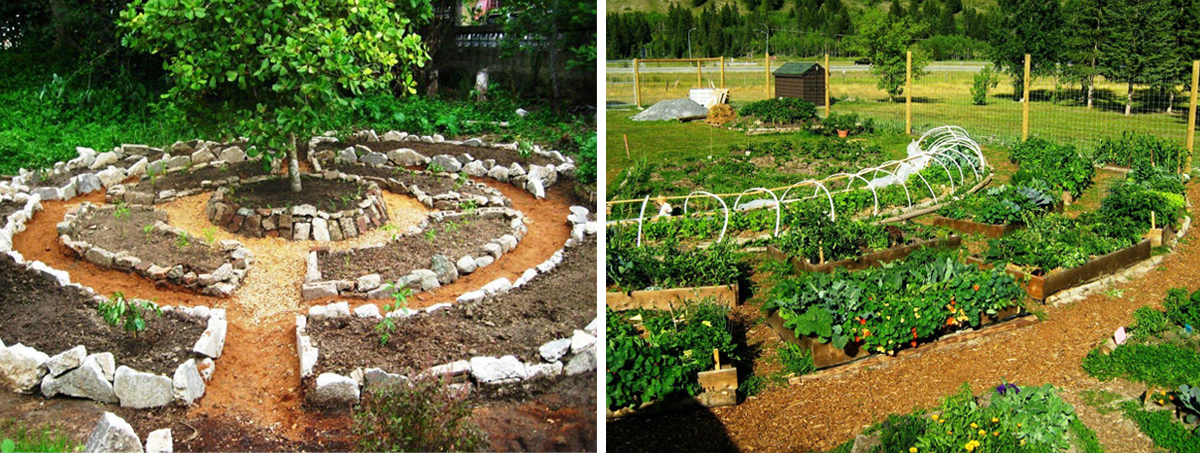by Linda Harvey, 2019 Celestial Planting Calendar
Permaculture and biodynamics are both forms of “conscious farming,” that is, farming that takes into account not only commodity production, but also consideration of the effects of production on the land, on renewable and non-renewable resources, on neighbourhoods and on social and cultural values. In other words, this is farming that puts all the variables into the equation, not just the ones that serve the bottom line.
Permaculture is more than a set of guidelines for this or that aspect of farming. It is a way of thinking that dovetails nicely with organic farming practices, including biodynamics. However, it can be adapted for pretty much anything: urban properties, business practices, even relationships.
The ethical underpinnings of permaculture systems are:
• Care of the earth;
• Care of people;
• Sharing of the harvest.
Superimposed on these values are 12 basic design principles to guide a person’s activity and thinking. The following is a brief explanation of each of these design principles.
Observe and interact: Understand your ecosystem fully before you make changes to it and carefully observe how these changes affect the system.
Catch and store energy: Energy is all around us in the form of sun, wind, and water. Harvest gently and use.
Obtain a yield: Act with clear intentions and goals. Yield includes not only tangible commodities but also intangible ones, such as a sense of satisfaction and a quality of life.
Apply self-regulation and accept feedback: Not only from your neighbors and friends but also from the ecosystem.
Use and value renewable resources and services: These are the core of your farm, garden or other activity.
Produce no waste: This principle seems difficult to implement. Some waste is probably inevitable, but a well-planned ecosystem will minimize this. Waste isn’t waste if a use can be found for it—for example, animal manure added to a compost pile is transformed into organic soil nutrients.
Design from patterns to details: The larger picture needs to be laid out before attending to details.
Integrate rather than segregate: Design your system so that the parts can interact in productive ways. Examples include keyline water management, use of animals in pasture management and companion planting.
Use small and slow solutions: Rather than launch into a huge project, make smaller interventions and note the results.
Use and value diversity: Diversity here means not only diversity of species on your land, but also diversity of projects and systems. For example, if there are several different means for generating electricity, then there is a better chance of coping successfully if there is a loss of any one of them.
Use edges and value the marginal: An example is the space where two types of habitat merge and support an incredibly diverse collection of organisms that live in either or both habitats. This principle can be applied in designing gardens and orchards.
Creatively use and respond to change: Change happens, even forests change. Herb and berry patches come and go. This change is normal. Then there are changes in the larger sense—new subdivisions, new regulations about wetlands, even climate change. It is important to observe, accept feedback and react.

These permaculture design principles are applied to all aspects of land use management, including the construction of buildings, land use planning, water management, soil maintenance, and livestock and crop management. A seasoned permaculture practitioner is expected to have at least some expertise in each of these areas. Some techniques for implementing these 12 principles include the following.
Social permaculture. Permaculture includes consideration of the local community structure, personal interactions and the interface with the larger world. Social permaculture is considered a particularly important component because, if humans are not working in harmony with each other, or are not happy, they tend to leave and the project is likely to fall apart. Many promising enterprises have failed for this reason.
Observation. The emphasis on observation, taking it slow, and being sensitive to the systems and creatures the farmer is working with, are closely compatible with the biodynamic approach. In my biodynamics course, we were taught about “Goethean observation,” a very stripped down, phenomenological approach in which observations are made without attempting to interpret or judge. While not identical to the permaculture observational style, both procedures lead to practical, reality-based information and insight.
Efficient design / Zone Concept. In permaculture design, one of the more efficient ways of arranging things on a farm is to place the things done most often or looked after most diligently within the immediate vicinity of the house. This area might contain a kitchen garden, maybe one or more relaxation areas, a heat-lamp facility for baby chicks, a sprout-germinating spot—things that take a lot of fussing.
Keyhole gardening. The keyhole bed is an important element of intensively gardened spaces, especially those close to the house. A short central path surrounded by several beds (a keyhole) forms a unit. Several such units radiating from a center or along a path allow for maximum access with minimum trampling. They also provide lots of edges for diversity and can be oriented towards the Sun to trap heat and light, or downhill to drain cold air and avoid frost traps.
Polyculture. Polycultures are communities of plants which support each other and are encouraged to grow in a configuration where each thrives and where all ecological niches are filled. In this way, they are relatively maintenance free and can be highly productive. Polycultures around fruit trees are common. There might be an understory of berry bushes, a taller and a shorter herb layer, ground cover and a root community, such as bulbs.
In summary, permaculture is more than a set of guidelines for efficiently conducting agricultural activities. It also recognizes the importance of human and social factors. These techniques can certainly enrich a biodynamic farming or gardening experience. Both approaches have much to offer each other.
Linda Harvey, is a retired medical doctor, moved to a small farm in eastern Ontario with her husband John. For the past five years, they have used biodynamic and permaculture practices on their farm, gardens and woodlot.
|


![]()

